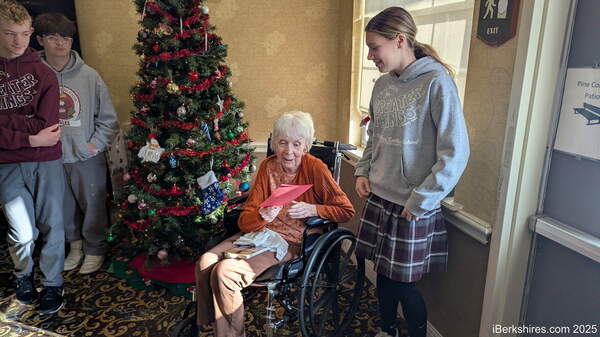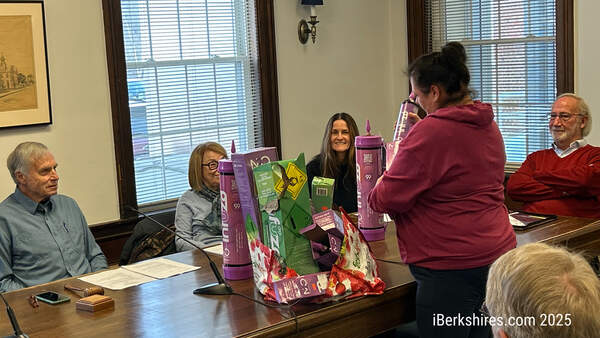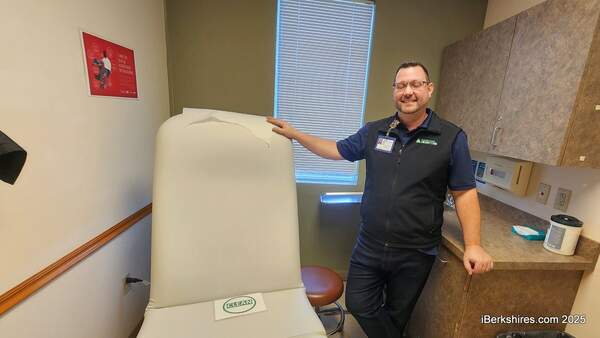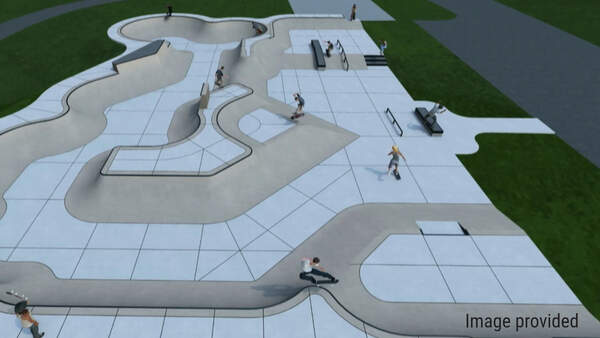Village Ambulance Service Meets Silver Milestone
 |
| Village Ambulance Service Inc. EMTs Chuck Poulton and Karen Rose in the back of a new VAS ambulance. The ambulance was purchased in December; in May, the VAS will celebrate its' 25th year of service. [Photo by Sue Bush] |
25 Years In Pictures
"Look at that, that was our '85 med-tech slant-side [ambulance]," Miller said as he pointed to photographs from decades past. "Here's where we did some training with the jaws [Jaws of Life rescue tool], and geez, here's another accident at the [Taconic] trail. And here's one of the big truck accidents out on Route 7 at the bridge [near the DeMayo Bonnie Lea Farm]."
<L2>For the ambulance service, the past quarter-century can be measured in lives saved and lives lost, appreciation letters, news articles, and professional changes. The Village Ambulance Service will celebrate its' 25th year of operations in May, and Miller has been there since the beginning. The service began rolling ambulances on May 24, 1982 from a Main Street-based Colonial Shopping Center site. The ambulance service operations base was located inside a former Sunoco fuel station that was renovated to accommodate an ambulance service.
The VAS is hosting an May 26 Open House at the Water Street headquarters to celebrate the 25th anniversary. The public is welcome to tour the facility from 10 a.m. to 2 p.m., and the scrapbooks will be available for public viewing, Miller said.
By The Numbers
According to information made available by Miller, between its' opening days and December 2006, the service responded to 37,336 calls.
Of those calls, 19,183 were emergency responses. During 2006, the VAS answered 2207 calls for assistance and 1198 were deemed emergency calls. The service provides 24-hour, seven-day-a-week emergency medical response services to residents of the town as well as Hancock and New Ashford.
While regulations, equipment, and training strategies have altered over the years, some things remain the same, Miller said.
"For me, the biggest challenge has always been dealing with [injured] children," he said.
During an April 6 interview at service's Water Street headquarters, which was opened in April 1993 and erected with a $130,000 gift from Williams College, on-duty emergency medical technicians echoed Miller's sentiments.
"Calls that involve kids in general are hard for me," said Chuck Poulton, a seven-year veteran of VAS. "Kids are not supposed to -they are not supposed - life is just beginning for them."
"Nobody Does This For The Money"
The EMT profession has evolved tremendously throughout the Northern Berkshire region over the past 25 years. EMT certification levels include basic, intermediate and paramedic - VAS counts 11 paramedics on the staff- and the work can be emotionally draining and physically rigorous. The pay is not particularly high; basic level EMTs may earn between $20,000-$25,000 per year locally, and those at the paramedic level may earn between $50,000 to $60,000 yearly, if employed in a full-time capacity and earning some overtime, said VAS Operations Manager Shawn Godfrey.
"Nobody does this for the money," he said.
William Mahoney is a 17-year VAS veteran EMT.<R3>
"It's the helping people," he said. "This is the town I was raised in and I like helping the people in the community."
Karen Rose has been a VAS EMT for five years.
"I think that in the long run we make a big difference in people's lives and I like that," she said.
Poulton said he believes he serves as an advocate for those who may need someone to act on their behalf during an emergency situation.
"I have Tourette's syndrome, and as a youngster, I was put on a medication that had a bad side effect. I know how important it is for a patient to have an advocate, someone who is really paying attention to them and what may be going on with them. I think this is especially important for the elderly and for kids."
Alex Steele has been on the job for about a year.
"This isn't a shrinking field," he said. "It's a growing field and there's a lot of opportunity. The work isn't going to go away."
A History Larger Than Themselves
<L4>Local history certainly seems to lend credence Steele's assessment of emergency medical services' present and future. When Bert Miller's grandfather Everett W. Miller founded the town's first ambulance service in 1927, Hopkins Ambulance Service was the first of its' kind in the state and among the first organized ambulance services in the nation. The Hopkins service first ambulance was a De Soto vehicle that was purchased from Massachusetts Gov. Alvan T. Fuller, who was a handicapped person. The De Soto had been altered to accommodate Fuller and the alterations made the vehicle well-suited for the transport of injured or ill individuals.
The service operated in a consistent manner with little change until 1954, when the Hopkins Ambulance Service purchased a new, 1954 Pontiac ambulance. The De Soto permitted patient loading via specially-designed side doors; the new model afforded rear-loading of patients. Bert Miller's father Everett H. Miller joined the service during the 1950s. Again, operations remained fairly consistent until 1972, when the North Adams Regional Hospital opened a 24-hour emergency department. That action generated a need for 24-hour ambulance services and was the catalyst for an ambulance service staff increase and increased hours of operations.
Bert Miller, who in 1972 met the state's 16-year-old minimum EMT age requirement [the age is now 18 years old], enrolled in cardiopulmonary response classes and EMT training classes and became a member of the Hopkins Ambulance Service. By early 1982, Bert Miller was leading the Hopkins Ambulance Service operations - and announced that due to financial pressures, the private entity would close in March of that year. Changes in state regulations during the preceding decade proved costly to implement, and as was the situation with the privately-operated Mohawk Ambulance Service, which had already ceased operations, the Hopkins service was unable to sustain itself.
The Start Of Something New
According to information provided by Miller, town Selectmen and town residents were very concerned about losing a town-based ambulance service.
After numerous meetings, board appointments and paperwork, the Village Ambulance Service was launched as a non-profit agency with Mary Lou Galusha as the VAS president, Miller as manager, and Miller's wife Cara Miller as the service's clerk.
A capital fund drive was initiated and that effort raised $60,000 dedicated to the VAS. The new non-profit service purchased the two ambulances from the former Hopkins service. The VAS was initially staffed with 26 emergency medical technicians.
Currently, the VAS hosts 37 full and part-time employees. In addition to the paramedics, there are intermediate and basic level EMTs providing emergency medical services and patient transfer assistance for the service area.
Ambulances are replaced every five years; in December, the VAS bought a new ambulance.
On The Front Lines
The VAS has been at the forefront of emergency medical response evolutions since its' opening.
During the early 1980s, the VAS introduced an EMT training program to Williams College students. The curriculum is still taught as a Winter Study offering, and the result has been a consistent Williams College student presence among the VAS employees.
The VAS was among the first ambulance services in the state to be licensed as able to deliver advanced life support to patients. In 1985, the VAS was given the first license ever granted by the state that permitted EMT operation of manual defibrillators. In 1988, the town's Lions Club raised money to purchase the tool known as "the jaws of life" for the VAS.
The ambulance service maintained the "jaws" until recent years, when the tool became part of the town's volunteer fire department rescue equipment arsenal.
Before Paramedics, There Was A Life Team
Mahoney reviewed other changes.
"Call volume has changed; it's gone up. The number of personnel has increased and we need more people. And when we first started, there were no [ambulance-employed] paramedics. There was a Life Team that would come out from BMC [Berkshire Medical Center in Pittsfield] and intercept ambulances that were on the way to the hospital."
The Life Team consisted of BMC emergency department nurses who were RNs and also certified as paramedics. The program was administered by Daniel Harrington, a RN who worked at BMC. Harrington remains active as a per diem VAS EMT.
"There is a lot more involvement with community education now," said Mahoney. "We do CPR and auto defibrillator training for schools and other places that have to know these things. The laws have changed."
Miller noted that the ambulance service serves the residents of two long-term care centers and an assisted living complex as well as the three communities-at-large. As skateboards and rollerblading became popular, youth-related "high velocity" calls increased. As the baby boomer generation grows, calls involving elderly individuals increase.
The VAS also serves Jiminy Peak.
"We get a lot of ski calls," said Mahoney.
With such a diverse population, the VAS must stay current with EMT advancements, Miller said.
"We work hard to keep up with what's going on," he said.
During Just One Year ...
The service is licensed in Massachusetts and Vermont as an Advanced Life Support-Paramedic level ambulance service. During the past year, in-house education has included National Incident Management Systems education, mass casualty incident classes, emergency vehicle driving courses, emergency preparedness, incident command and bloodborn pathogen and infectious control education. a 30-member EMT refresher course was held at the former Hopkins Ambulance Service site on Spring Street. The VAS was among a trio of agencies that participated with a mock airplane crash at the Harriman-West Airport in North Adams. VAS instructors taught a "Choke Saver" program at area restaurants ; 75 restaurant servers were trained with how to assist choking patrons.
The service is in the midst of earning state certification to offer basic and intermediate level EMT instruction. Several VAS EMTs have attended a Traumatic Brain Injury instructor program, have completed instructor training for emergency vehicle driving, and three EMTs are presently enrolled in an EMT instructor training program.
A 2006 membership drive raised $65,000, $2,000 more than a $63,000 goal.
In conjunction with the Visiting Nurse Association and Hospice of Northern Berkshire, the VAS initiated a "Sentimental Voyages" program, which provides medically supportive transportation to meaningful regional destinations for terminally ill individuals.
Additional information about "Sentimental Voyages" is available at a www.iberkshires.com/story.php?story_id=21742 Internet web site.
The Key Thing
The VAS provides contracted ambulance services to the town of Pownal, Vt.. The VAS responds to emergency calls from the Vermont town from 6 a.m. to 6 p.m. Mon.-Fri.. And the VAS is included in a mutual aid agreement between Northern Berkshire and Southern Vermont communities.
"Mutual aid is a big part of what we do," Miller said. "I am so appreciative of what the North Adams and Adams [ambulance] services do to help us. It's the key thing, that everybody works together, It's like coverage to Pownal; they are our neighbors and we're being neighborly."
Standardized training and ambulances help EMTs know what to do and where to find things when the ambulances roll. The "everything the same" policy is deliberate, Miller said, and he noted that EMTs do not want to waste time searching for items that are put in different places in different ambulances. For an EMT, consistency does not equal monotony but does provide a potentially life-saving efficiency, he said.
The Helping Hands
Active EMTs with over 20 years of service at the VAS are Bert Miller, Jeff Quimby, and Greg Chapman. Those with over 10 years of service are Mahoney, Mark Chretien, Cara Miller, Heather Boudreau, Pamela Costine, Kevin Garvey, Marilynn Kirby, and Ken Sagendorph. Those with over five years service include Godfrey, Rose, Poulton, and Robert "R.J." Pensivy.
Additional information about the Village Ambulance Service Inc. may be acquired by calling 413-458-4889.















